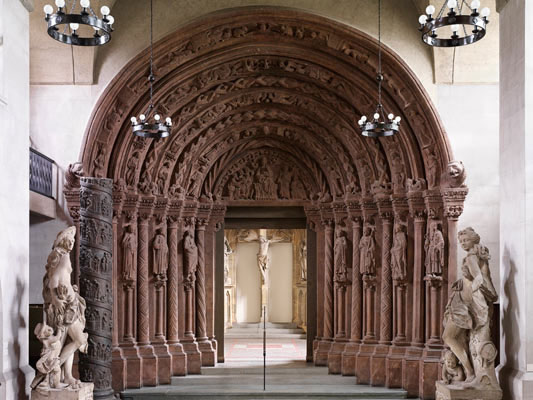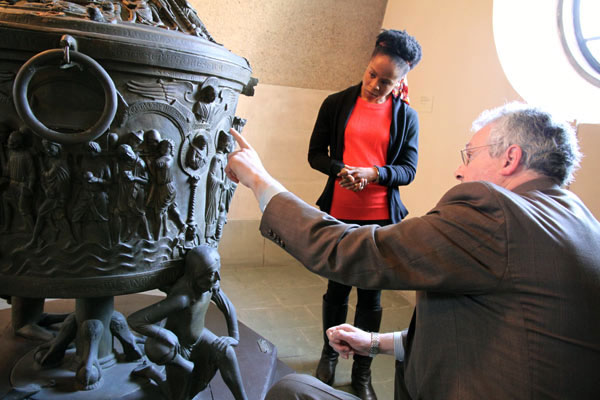Inside Adolphus Busch Hall stands an impressive one-to-one replica of the Golden Portal of the Church of Our Lady in Freiberg, Germany. “Everyone is always amazed by it, especially because of the scale,” said Denva Jackson, a graduate student in the History of Art and Architecture. “Most students don’t have a sense of scale, because we look at slides [in the classroom]. You won’t see scale like this outside Europe. It’s a real treat.” This monumental arch is one of several plaster casts of German sculpture from the Middle Ages displayed in Adolphus Busch Hall, former home of the Busch-Reisinger Museum.
Tucked away beside the Center for European Studies, this space is among the university’s unique teaching resources. Looking closely at the plaster casts lets students explore their size, materiality, texture, and three-dimensionality. Last fall, for instance, Harvard freshmen used these objects as inspiration in their exploration of drawing and sculpting techniques.
Professors like Jeffrey F. Hamburger, the Kuno Francke Professor of German Art & Culture, use the plaster casts to help students understand how to discriminate between originals and copies. “One of the very first things I do is ask students which of the various objects here is not in fact a plaster cast, but an original. To this day, after 15 years, I’ve yet to bring a class into this space and have a student immediately be able to point out the one object or set of objects that is not a copy,” said Hamburger. (The answer is The Four Seasons sculptures.)
Hamburger cites the Golden Portal as a prime example for demonstrating the deep understanding that comes from experiencing an object in person. When encountering the Old Testament figures that adorn the lower level of the arches, students begin to see how the figures’ positions and postures are meant to direct the viewer’s line of sight and set a particular mood. For example, an animatedly posed prophet Daniel at the forefront cues that this is a joyous space. “The [figures] embody a complex symbolic program, but are also here to interact with the body of the viewer,” said Hamburger.
As more human interactions move into the digital world, professors have the special task of reinforcing the importance of hands-on teaching experiences. “We live in a day and age in which students come to the world through their computer screens. This plaster cast collection allows students to escape from the flat lands of the virtual world and begin to get some sense of what it is like for actual human bodies to interact with three-dimensional reproductions of the human body.”




